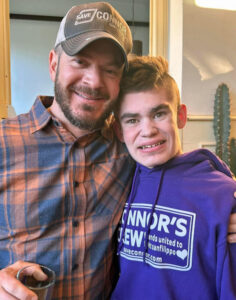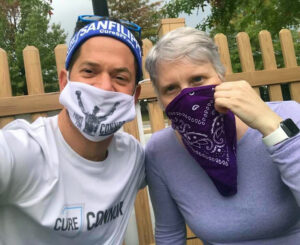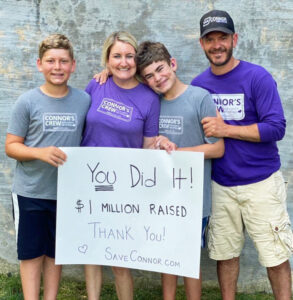Reflections of a Sanfilippo Dad: 5 Years Later
By GuestBy Mike Dobbyn
It was March 20, 2019, and I was reading my son’s obituary on my iPhone while sitting in the geneticist’s office at DuPont Nemours Children’s Hospital in Delaware. My oldest son Connor, 10 1/2 years old at the time, had just received what seemed to be a death sentence.
Connor’s mother, Marisa, and I were sitting next to each other in the doctor’s office, listening intently as only worried parents can, while a geneticist and her assistant informed us that initial rounds of genetic testing indicated a very high (“97 percent”) likelihood that Connor had an incredibly rare genetic disorder called Sanfilippo syndrome (MPS 3C). Further enzyme testing would still be needed to confirm the diagnosis.
“I suggest you don’t go Googling anything yet until we know for sure,” the young geneticist cautioned right away — which of course led me to immediately reach for my smartphone. As the geneticist turned away to review her notes, I quickly and surreptitiously yanked my cell phone from my pocket and held it below seat level to disguise what I was about to do.
My left thumb trembled as I hastily typed “Sanfilippo syndrome” into the search bar. I didn’t want Marisa to see me Googling it either. I was scared enough; I didn’t want to tip her into panic mode as well. Marisa and I had amicably separated a few years prior, which presented its own additional challenges, and I didn’t want to force any information on her. Why jump the gun before receiving the ‘official’ diagnosis? We all deal with stress and trauma differently, after all.
What immediately caught my eye was the section on Sanfilippo life expectancy: ‘Early to late teens.’ I almost threw up on myself when I read it. Connor was nearly 11 years old at the time. What would that mean for him … and for us?
The new likelihood — not merely a possibility, but a reality — that I will one day have to bury my own child hit me hard.
A terrifying new reality
In the days and weeks that followed, I was lost in a cloud of pure panic and terror. This was every parent’s worst nightmare, except that it was now our reality. I felt alone. My support system was there for me in every conceivable way they knew how, as they’ve been throughout my life. But family and friends who try to help those of us experiencing very personal and serious traumas don’t necessarily ‘get it,’ and that’s through no fault of their own. This isn’t a scenario where someone can actually put themselves in your shoes — unless, of course, they have a Sanfilippo child of their own.
The unknown is terrifying. Horror movies become much less scary after we’ve met the monster. So I needed to gain some control by arming myself with knowledge. Sanfilippo syndrome is an “ultra-rare disease” that affects one in 75,000 children. Those of us confronting the diagnosis may be considered ‘rare,’ but globally there are a lot of us out there.
Possessed by a desperate need to learn about this scary new world I was now a part of, I began my personal mission to find the people and organizations that could help hold my family’s hand through the daunting journey that awaited us — and awaits us still. Social media quickly became the most efficient way of finding them.
Standing back up
Initially we had only shared Connor’s diagnosis with immediate family members and closest friends. During those months of secretly grieving and digesting this harsh new reality, I spent a lot of time hiding under my bed covers. I couldn’t sleep. But I also lacked the motivation to get out of bed. And I didn’t want to socialize with or talk to anybody. Over the next two months I lost 15 pounds from lack of appetite. In early June of 2019 I finally raised my head to attempt to figure this out.
Jenna (to whom I am now married) knew what I was going to need as I began to immerse myself in this Sanfilippo world we were now part of, and she quietly took the reins of locating the resources and organizations and online Sanfilippo parent chat groups.
As a society, we may be questioning the value of social media, but I am a fan. It was the strength of the Sanfilippo community and great family-sponsored organizations that provided some direction — and even hope — for this fresh new Sanfilippo dad looking to find his way out of a very dark hole.
The first Sanfilippo-related organization to reach out to me and my family was the National MPS Society. They provided us with information about the disease, tips on how to deal with the school and educational planning, as well as many other timely and practical topics we would need to immerse ourselves in right away as parents (and now advocates) for a child with severe special needs and cognitive regression. Soon after that call, I had phone calls with Team Sanfilippo and Cure Sanfilippo Foundation. All of these calls lifted my spirits and provided me with a sense of family and camaraderie, and with hope and inspiration.
One mother’s name kept getting mentioned during all of these calls, a woman by the name of Jill Wood from Brooklyn, NY.
Jill has a son with Sanfilippo type C who is the same age as my son. She founded a biotech company several years prior in the hopes of launching a clinical trial and one day solving Sanfilippo. Jill’s story was a revelation. We had a long phone call one Sunday night that lasted more than two hours. Following that call, I began to feel inspired and morally compelled to get in the game and join the fight to save our kids’ lives.
Turning trauma into action
The very next morning I woke up early for work and paced around my bedroom for 15-20 minutes. I stepped into the bathroom, intently stared myself dead in the eyes for a solid minute, and told the person staring me back in the mirror, out loud, “We’re going for it.” I got dressed for work, fastened my tie, hopped in my car, drove to work.…
Yet I decided at the last minute to sail past my work exit and drove straight to Brooklyn instead.
Two hours later, I reached the building where Jill and her small team at Phoenix Nest were hustling against all odds to bring a clinical trial to life.
Meeting Jill in person felt surreal, the way one might feel upon meeting a sister that you never knew you had. In fact, we in the Sanfilippo community often refer to one another as ‘Sanfilippo siblings’ because of the rare and unique instant bond that we share as parents of uniquely brave and suffering children. What was supposed to be a “quick coffee meeting” to say hello and get acquainted turned into a 48-hour stay in Brooklyn. I ended up camping out the first night on a spare sofa in her office, and the second night at her family’s apartment a few blocks away.
It was there that I met Jonah, whose similarities to my son Connor sent shivers down my spine. I spent most of those two days in Brooklyn learning from Jill, soaking in every piece of advice and direction that she was sharing.
Jill taught me about the disease and stressed, above all else, that there is just not enough money and awareness devoted to it. That’s just the sad, brutal, unfair reality of the rare disease world — especially for an ultra-rare disease like Sanfilippo syndrome. We need all hands on deck to fund a clinical trial and to one day find a cure. And parents are on the front lines of that fundraising and awareness fight.
As I headed out the door of Jill’s office building she exhorted me to connect with the Cure Sanfilippo Foundation to help launch a fundraising campaign to fund a potentially life-saving clinical trial for children with Sanfilippo syndrome type C, the long and arduous mission that Phoenix Nest has been on for more than a decade now.
The Cure Sanfilippo Foundation was founded by another pair of heroic parents, Dr. Cara and Glenn O’Neill in 2013, to raise funds for a clinical trial for their daughter Eliza (type A). Since then, the foundation has played a key role in the fight against the disease — not only funding medical research and clinical trials, but also mentoring and assisting other Sanfilippo families and our communities.
These amazing people are ordinary human beings made extraordinary due to raising children with severe special needs and a brutal and degenerative disease. They achieve things far outside of their comfort zones because that’s what people do when their children’s lives are on the line. In the Sanfilippo world, many parents are on the front lines in that regard. I wanted to be one of them.
Advocacy leads to ‘Save Connor’ and ‘Sanfilippo Project’
I met the co-founders of CureSFF in their home in Columbia, SC, along with their daughter Eliza. Shortly thereafter, Marisa and I began having regular and frequent Zoom calls and strategy sessions with Glenn and his team — culminating in the launch of the Save Connor campaign, along with the release of a three-minute “Save Connor” film in October 2020 that became our main fundraising vehicle.
As I look back now — five years after diagnosis day — it is clear that it was the organizations and selfless parents along my journey that helped me greatly to process an unspeakable trauma and turn it into action. And, of course, our community has been amazing, supportive and inspiring beyond my wildest imagination. I’ve had a front-row seat to humanity at its very best and most noble. Together we’ve raised more than $1.5 million for the fight so far. A clinical trial for type C is still a ways off (due to funding needs, FDA hurdles…the list goes on), but progress is being made and the world is beginning to learn about this disease.
This scary, beautiful, impossible journey over these past five years has taught me a lot about myself. But it was not easy, and the steps were often clumsy.
At 42 years old (in 2019), I was experiencing a midlife crisis on steroids: stressing not only about my own mortality, but now my son Connor’s as well. The intensity and immensity of those darkest-of-all thoughts and fears overwhelmed me, and I shaved my head in a total mental breakdown at 3 a.m. on a Saturday, exactly one week after going ‘Facebook public’ with the news about Connor.
To prepare for the battle that my son was facing, I had to prove to myself that at least I had the courage to shave my own head. I was physically transforming myself into a soldier going into the battle that I was about to confront.
The very next day, upon viewing the hacked-up devastation that was my new hairstyle, Jenna intervened and scheduled me to start seeing a therapist ASAP. I hated the idea of therapy, but I let her and my parents convince me that I needed professional help. And you know what? They were right. And it’s been worth it. It took years to truly open up. I was lucky to find a therapist I connected with and we explored ways to find peace and tranquility even when my mind is in the darkest corners. And for that I am extremely grateful.
I am not “okay,” and maybe I never will be. That is a fantasy. I still work every moment of every day to process the reality of my son’s condition and its impact on my family, myself, and on all of those who love him so much. But I am “better” — certainly better than I was earlier in this journey, when I was in shock and alone.
I get by with a little help from my friends
I play a lot of soccer. It provides camaraderie, connection and healthy competition. The men’s 35+ soccer league that I play in was a release valve throughout COVID for all of us on the team. The friendships I made through playing soccer helped me overcome the depression that I felt during the pandemic and it inspired me to apply that lesson here.
I may have found therapy to be valuable, but I’ve never been a guy who talks openly about feelings and fears and other stuff like that because I hate burdening others with my own baggage. It always felt selfish to me.
The reality is that talking about these topics is hard. It’s hard to talk about it with our families; it’s hard talking about it with a therapist you are paying to listen to you. But my experience through my soccer league suggested a path: Let’s start by at least talking about it with other dads who are experiencing the same trauma and loss. This led me to launch a series of roundtable conversations for Sanfilippo dads called the #Raredads Roundtables, which I will host. I don’t expect it to be easy. But I do expect it to be rewarding.
My ultimate hope for these discussions is an ongoing, open and honest dialogue amongst dads sharing similar journeys who are interested in learning from other dads and are willing to share their stories as well. This can be a place where we have conversations about stuff that we’re not prone to having with other people in our lives who don’t walk in similar shoes.
I want to learn from dads like Lew Montgomery, a former star running back at the University of Iowa, but also a man whose son Lucas waged an incredible battle against Sanfilippo syndrome. That battle inspired his family to continue to fight for a cure. And in the words of Lew, “We decided right away, as a family, that we were going to move forward with him, rather than on without him. And that’s what we continue to do to this day.”
Having a platform to tell my story over the years has been helpful and therapeutic in my ongoing recovery. That’s why I started the Sanfilippo Project (sanfilippo-project.com) — to help others share their stories as well. In order to learn from one another, we need to get our stories out. And then we need to help others tell their stories. It’s a beautiful cycle, lighting small bonfires all over the place and ultimately mashing into a wildfire of impact and positive change. The Sanfilippo Project is a self-empowerment platform that aims to do just that. And it only works if we all pitch in. I look forward to taking this journey with you. Let’s do this.
I look forward to our conversations — every rare dad is the ultimate expert in his own journey. Every single human being, for that matter, is the ultimate expert in his or her own story, and I look forward to sharing those stories.
#SanfilippoProject #Learn #Share #PayItForward
Short URL: https://www.thecantoncitizen.com/?p=124971













